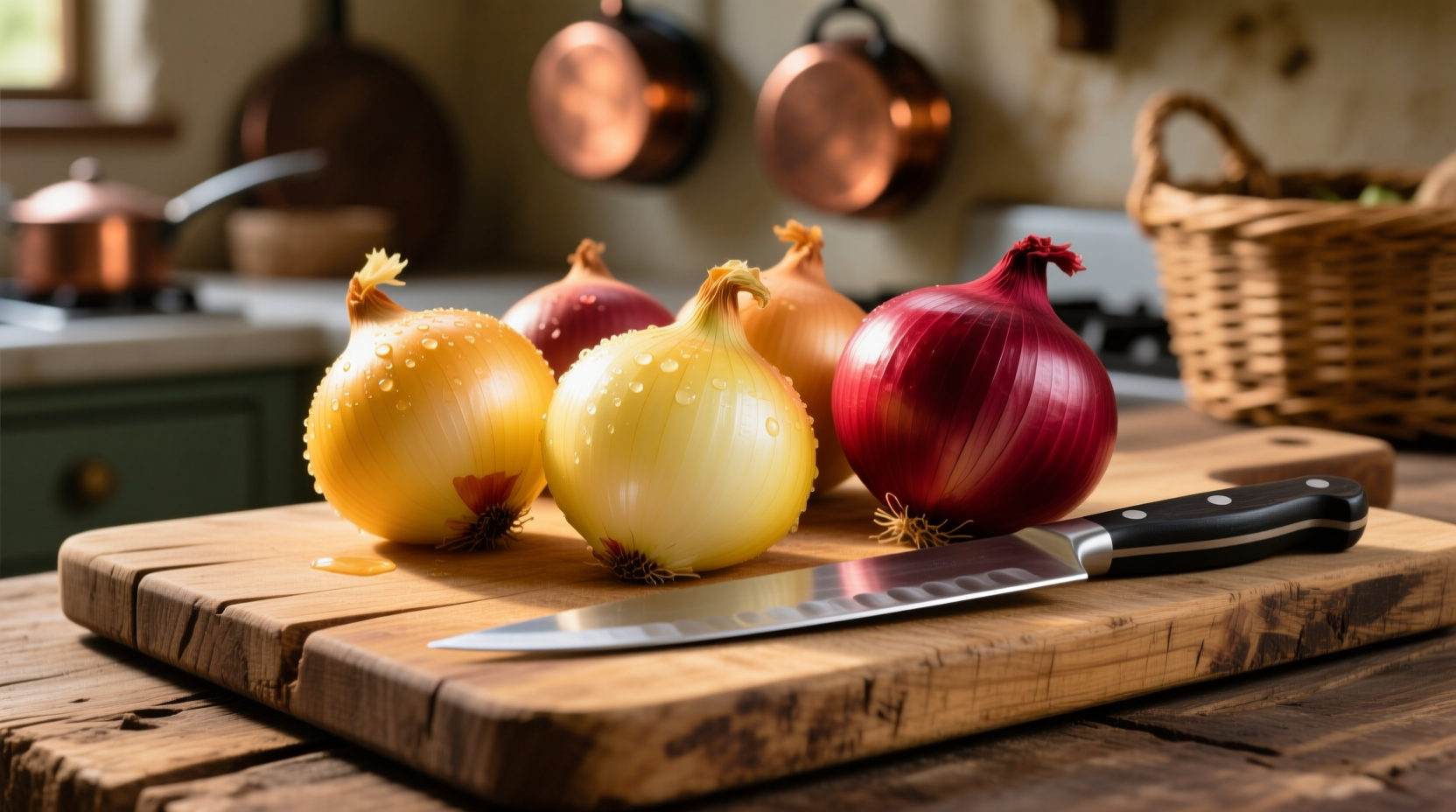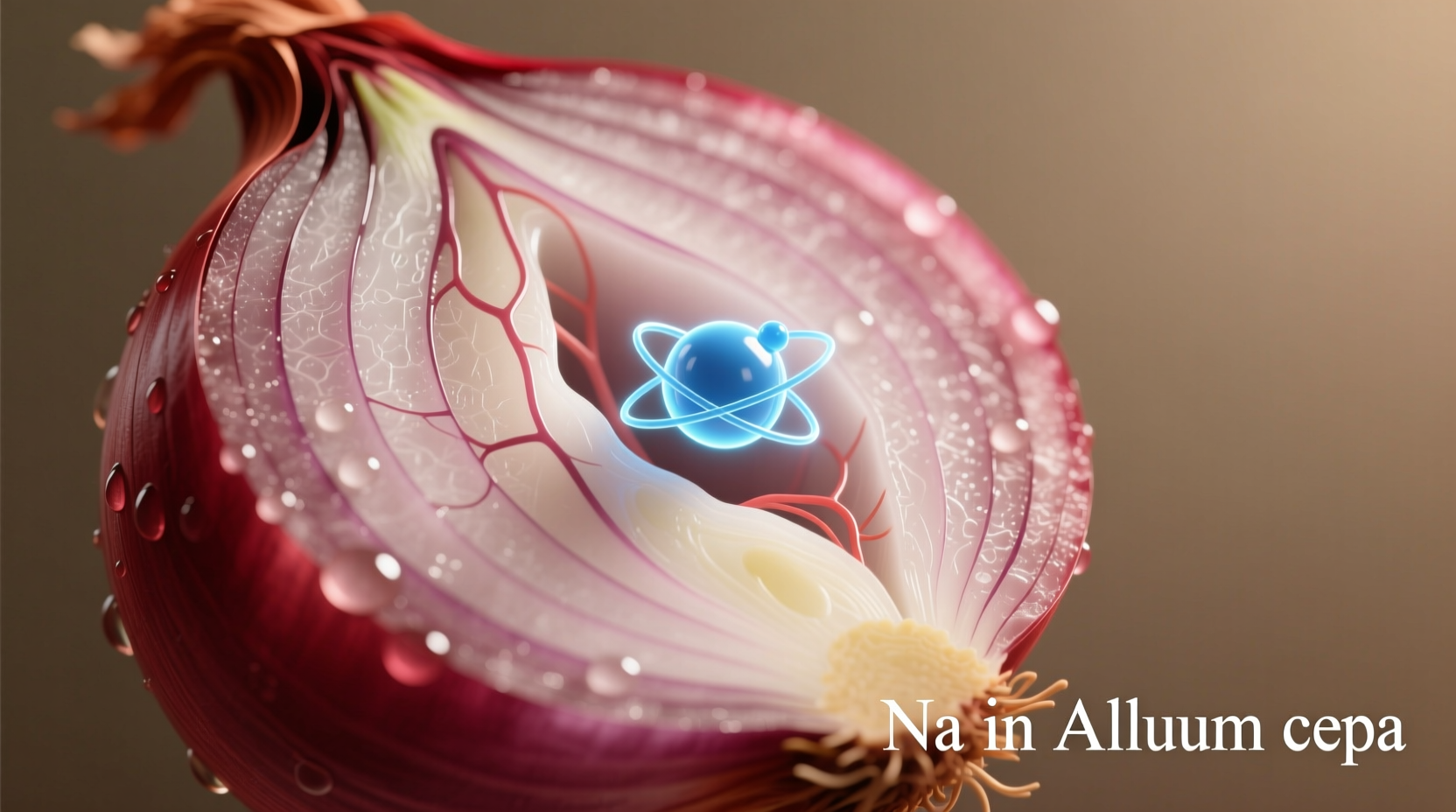When you're monitoring your sodium intake, understanding the natural sodium content in common ingredients becomes essential. Onions, a kitchen staple worldwide, offer surprising benefits for those following heart-healthy or low-sodium eating plans. This comprehensive guide breaks down exactly what you need to know about sodium in onions, backed by authoritative nutritional data and practical culinary insights.
Understanding Sodium Content in Different Onion Varieties
Contrary to what many believe, onions naturally contain minimal sodium. According to the USDA FoodData Central database, the sodium content across common onion varieties remains consistently low:
| Onion Type | Sodium (per 100g) | Percentage of Daily Value |
|---|---|---|
| Yellow Onion (raw) | 4 mg | 0.2% |
| Red Onion (raw) | 3.5 mg | 0.2% |
| White Onion (raw) | 4.2 mg | 0.2% |
| Green Onions (raw) | 5 mg | 0.2% |
| Caramelized Onions (cooked) | 5-7 mg | 0.3% |
This data confirms that onions contribute negligible sodium to your diet. For context, the American Heart Association recommends no more than 2,300 milligrams a day, moving toward an ideal limit of 1,500 mg for most adults. You would need to consume approximately 37.5 pounds of raw onions to reach even the lower recommended daily limit.
Why Onions Are Perfect for Low-Sodium Eating Plans
Onions serve as a powerful flavor enhancer without adding significant sodium. Their natural compounds create savory depth that can reduce the need for added salt in recipes. When caramelizing onions, their natural sugars develop complex flavors that satisfy the palate without sodium enhancement.
Unlike processed foods where sodium content can vary dramatically, onions maintain consistent low sodium levels across growing regions and seasons. This reliability makes them a dependable ingredient when planning meals for hypertension management or heart-healthy eating.

Comparing Onions to Other Common Vegetables
When evaluating sodium content across vegetables, onions rank among the lowest. Most fresh vegetables naturally contain minimal sodium, but onions offer particular advantages for flavor development:
- Onions vs. Garlic: Garlic contains slightly less sodium at 1.7mg per 100g, but onions provide more volume and versatility in cooking
- Onions vs. Celery: Celery contains about 80mg sodium per 100g - significantly higher than onions due to its water content
- Onions vs. Tomatoes: Tomatoes contain approximately 5mg sodium per 100g, making them comparable to onions
The key difference lies in how these vegetables function in cooking. Onions form the flavor foundation for countless dishes worldwide, allowing cooks to build complex tastes without relying on salt. This culinary role makes their low sodium content particularly valuable for health-conscious cooking.
Practical Cooking Applications for Sodium-Conscious Diets
Professional chefs leverage onions' natural properties to enhance flavor while minimizing sodium. When preparing meals for low-sodium diets, consider these evidence-based techniques:
- Slow caramelization: Cooking onions slowly over low heat for 30-40 minutes develops natural sweetness and umami compounds that satisfy the palate without salt
- Layering raw and cooked onions: Combining raw red onions for brightness with cooked yellow onions for depth creates complex flavor profiles
- Using onion tops: Green onion tops contain slightly more sodium but add vibrant flavor with minimal quantity needed
- Creating onion broth: Simmering onion skins and ends in water produces a flavorful sodium-free cooking liquid
Research published in the Journal of Food Science demonstrates that dishes incorporating properly caramelized onions receive higher flavor satisfaction ratings from participants, even when sodium content is reduced by 30-40% compared to standard recipes.
Addressing Common Misconceptions About Onions and Sodium
Several myths persist about onions and sodium that deserve clarification based on nutritional science:
Myth: Cooking onions increases their sodium content
Fact: Cooking concentrates flavors but doesn't increase sodium. Any slight increase in mg per 100g comes from water loss, not actual sodium addition.
Myth: Pickled or preserved onions have the same sodium content as fresh
Fact: Preserved onions absorb sodium from brines - a critical distinction between natural and added sodium that many consumers misunderstand.
Myth: Different growing methods affect onion sodium levels
Fact: Soil composition has minimal impact on sodium content in onions, unlike some other minerals. The USDA database shows consistent values across growing regions.
When Onion Sodium Content Matters Clinically
For the vast majority of people, the trace sodium in onions poses no concern. However, in extremely rare medical situations requiring near-zero sodium intake, even natural vegetable sodium becomes relevant. Patients with severe kidney disease on specialized renal diets might need to account for all sodium sources.
The National Kidney Foundation notes that while onions remain among the lowest-sodium vegetables, patients on ultra-restricted sodium diets (under 500mg daily) should work with a registered dietitian to calculate all sodium sources, including natural vegetable content. For context, these patients would need to consume more than 12.5 kilograms of onions to reach even this extremely low limit.
Maximizing Onion Benefits in Your Diet
Understanding the negligible sodium content in onions empowers you to use them generously as flavor builders. When following low-sodium eating patterns, incorporate onions using these professional techniques:
- Start soups, stews, and sauces with a "sofrito" base of onions, garlic, and peppers
- Roast whole onions to bring out natural sweetness without added fats
- Create onion-infused oils for dressings and marinades
- Use raw onions sparingly as finishing elements for brightness
These methods help satisfy your taste preferences while maintaining healthy sodium levels. The Academy of Nutrition and Dietetics confirms that building flavor with aromatic vegetables like onions is one of the most effective strategies for reducing dietary sodium without sacrificing taste satisfaction.
Frequently Asked Questions
Do onions contain sodium naturally?
Yes, onions contain approximately 4 milligrams of sodium per 100 grams naturally. This trace amount is considered negligible for dietary purposes and doesn't contribute meaningfully to daily sodium intake.
Are onions good for a low-sodium diet?
Onions are excellent for low-sodium diets as they contain minimal natural sodium while providing significant flavor. They help reduce the need for added salt in cooking and are recommended by the American Heart Association as flavor builders for heart-healthy eating.
Does cooking onions increase their sodium content?
Cooking doesn't increase the actual sodium content of onions. Any slight increase in milligrams per 100g results from water loss during cooking, not additional sodium. Caramelized onions contain about 5-7mg per 100g, still negligible for dietary purposes.
How do onions compare to salt for flavor enhancement?
Onions provide complex flavor compounds including sulfur-containing molecules that create umami and savory notes. Research shows properly prepared onions can reduce the need for added salt by 30-40% while maintaining flavor satisfaction, making them superior to salt for long-term health.
Can I eat unlimited onions on a sodium-restricted diet?
For most sodium-restricted diets, onions can be consumed freely due to their negligible sodium content. Only in extremely rare medical cases requiring near-zero sodium intake would onion consumption need monitoring, and even then, significant quantities would be required to impact sodium levels.











 浙公网安备
33010002000092号
浙公网安备
33010002000092号 浙B2-20120091-4
浙B2-20120091-4